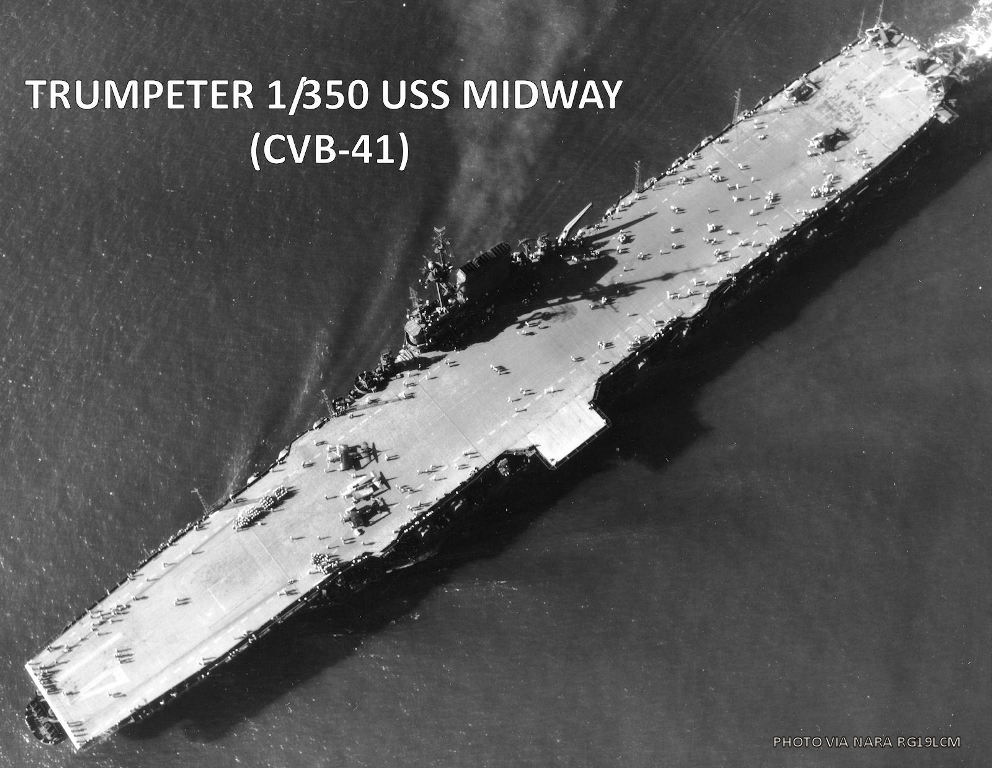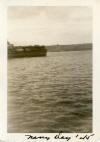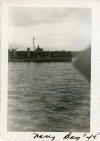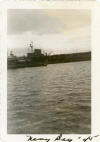

|
by Martin J Quinn |
|||||||||||
| HISTORY | |||||||||||
|
USS Midway
(CVB/CVA/CV-41) was the lead ship of her class of United States aircraft
carriers. Named for the epic US victory in June, 1942, she was commissioned
8 days after the end of World War II. Midway was the largest
warship in the world until 1955, as well as the first U.S. aircraft carrier
too big to transit the Panama Canal. She operated for 47 years, during
which time she saw action in the Vietnam War and served as the Persian
Gulf flagship in 1991's Operation Desert Storm. Decommissioned in 1992,
she is now a museum ship at the USS Midway Museum, in San Diego, California,
and is the only remaining inactive U.S. aircraft carrier that is not an
Essex-class aircraft carrier.
Midway was laid down 27 October 1943 in Shipway 11 at Newport News Shipbuilding Co., Newport News, Virginia; launched 20 March 1945, and commissioned on 10 September 1945. After shakedown in the Caribbean, Midway joined the U.S. Atlantic Fleet training schedule, with Norfolk as her homeport. From 20 February 1946, she was the flagship for Carrier Division 1. In March, she participated in Operation Frostbite testing the Ryan FR Fireball and helicopter rescue techniques for cold-weather operations in the Labrador Sea. For more on the Midway, see her Wikipedia page here, or her page on Naval Encyclopedia here. |
|||||||||||
| The
Trumpeter USS Midway (CV-41)
The Trumpeter USS Midway (CV-41) comes in a very large cardboard box, in typical Trumpeter style. Midway is a big girl, and the box reflects this, coming in at around 34" long. The box is crammed with a whopping total of 59 sprues, though 18 of these are the small individual sprues for the 5"/51cal guns, while 12 account for the aircraft that are included in the kit. Also included are eight (8) photo-etch frets, a display stand and anchor chain. The model - which has been at the top of a lot of folks wish lists for a long, long time - represents Midway "as-built", in October 1945. She didn't stay in this configuration for long, having her bridge modified and extended in a 1946-1947 refit. This is the first 1/350 scale of Midway, in any configuration, to be released. Previous as-built versions include the venerable Revell 1/547 and Loose Cannon 1/700 releases. Tom's Modelworks makes a 1/700 kit, that depicts the Midway after her 1957 refit, while Orange Hobby and Jim Shirley both made 1/700 kits, and Arii made a 1/800 model. The Jim Shirley and Arii kits appear to depicts the ship after her late 1960's refit, while the Orange Hobby kit is supposed to be a "Gulf War 1991" (final) version. |
|||||||||||
|
|
|||||||||||
| THE HULL (SPRUE A) | |||||||||||
| As befitting a huge box, the hull - which seems to scale out in length and beam - is a big one, taking up the entire length of the box. There is an armor belt present, along with some detail on the hull - recessed openings to replicate mooring bits, some strakes and some small bumps (I'm not sure if these are supposed to represent padeyes). As built, the Midway's inboard prop shafts were full skegs, similar to the Iowa class. On the model, the inboard shafts are shortened, with exposed struts, which didn't happen until a later refit. You can see the original skegs in the photos of the pre-construction model at the Midway museum, and the shortened skegs in her 1957 Booklet of General Plans. While this is a pretty big error, I suspect 95% of modelers won't care. If I live long enough to build this, I'll do it waterline, to eliminate the issue. | |||||||||||
|
|||||||||||
| DECK PARTS | |||||||||||
| There are two large decks included in the kit - the hangar deck (sprue B) and flight deck (sprue C). | |||||||||||
| HANGAR DECK (SPRUE B) | |||||||||||
| This deck is one large piece that
runs the length of the entire hull. All the detail on it is outboard
of the hangar bulkheads - once the model is completed, none of the hangar
deck will be visible.
There are raised locator rings for the 5"/51cal towers and mounts, as well as molded on "non-skid" surfaces. While I probably would have preferred decals, these are fairly subtle, and are a better rendition than what Very Fire did on their Atlanta kit. There is a bland, raised surface for the anchor chaffing plates, but no opening for the anchor chain to go into the hawse hole, though you won't be able to see much of this underneath the forward flight deck. |
|||||||||||
|
|
|||||||||||
| FLIGHT DECK (SPRUE C) | |||||||||||
| The large flight deck has engraved lines to mimic the non-skid coating that was applied to the deck. While the pattern matches photographs of the real ship, the lines seem to be a bit pronounced, but should look alright under a coat of paint. The flight deck barricade supports and the arresting gear sheaves look over-scale. I also found some mold lines around the edge of the flight deck, while will need to be cleaned up. | |||||||||||
|
|
|||||||||||
| SPRUE D | |||||||||||
| The long hull and enclosed hangars on the Midway-class necessitate lots of bulkheads, and these are spread out over a number of sprues, starting here. The bulkheads have nice detail on them, including finely done vents, though the fire hoses do appear to be under-scale. There are also none of the prominent open doorways that lead from the catwalks into the interior of the ship. The large 20mm gun platform at the rear of the ship is on this sprue, and the non-stick markings around each mount is well done. | |||||||||||
|
|
|||||||||||
| SPRUE E | |||||||||||
| More bulkheads and similar comments as above. | |||||||||||
|
|
|||||||||||
| SPRUE F | |||||||||||
| More bulkheads and similar comments as above. | |||||||||||
|
|
|||||||||||
| SPRUES G | |||||||||||
| More bulkheads and similar comments as above. | |||||||||||
|
|
|||||||||||
| SPRUE H | |||||||||||
| Even more bulkheads, along with the deck edge elevator. This elevator was planked, and the part reflects this difference from the main flight deck. | |||||||||||
|
|
|||||||||||
| SPRUE J | |||||||||||
| Here we find catwalks, platforms, the funnel cap and injection molded radars. Some of the catwalks have molded on inclined ladders. They aren't quite the infamous "Aztec" stairs, but these should have been included in the photo-etch set. | |||||||||||
|
|
|||||||||||
| SPRUE K | |||||||||||
| There are more catwalks and bilge keels on this sprue. The 20mm gun locations have that raised non-skid around them. | |||||||||||
|
|
|||||||||||
| SPRUE L | |||||||||||
| A good number of 40mm gun tubs are on this sprue, with the raised non-skid detail molded in. There are also a myriad of small deckhouse, some with nice vent detail, flight deck supports and the flight deck crane. The crane is a bit disappointing - it is a solid piece, with no PE option. | |||||||||||
|
|
|||||||||||
| SPRUE M | |||||||||||
| There are a boat load of doors for the hangar bulkheads, more supports for the flight deck and the outboard propeller struts. The bulkheads have very subtle lines to replicate individual vertical ladder rungs. | |||||||||||
|
|
|||||||||||
| SPRUE N | |||||||||||
| According to modeler Keith Bender, who has an unhealthy obsession with the undersides of ships, Midway was launched with four 4-bladed props. The kit has a pair of 5-bladed and a pair of 4-bladed props. The struts for the prop shafts, parts of the rudders and additional gun tubs are also found here. | |||||||||||
|
|
|||||||||||
| SPRUE P | |||||||||||
| Some ships boats, more flight deck supports, more catwalks and the name plate reside on this sprue. | |||||||||||
|
|
|||||||||||
| SPRUE Q | |||||||||||
| The decks under the forward and aft flight decks are on this sprue. Also found here is the secondary conn and flag bags. The detail on the sides of the parts is well done. | |||||||||||
|
|
|||||||||||
| SPRUE R | |||||||||||
| More ships boats - which have tiny molded on rudders and facsimile props - as well as director towers and more little deckhouses that populate the sides of the main deck, are here. There are some mold seams visible on these parts, which will require some clean up. | |||||||||||
|
|
|||||||||||
| SPRUE S | |||||||||||
| More deckhouses, that seem to sit inboard of the 5"/51cal gun towers, are on this sprue. You'll find some molded on vertical ladders and ladder rungs, as well as W/T doors on these parts. | |||||||||||
|
|
|||||||||||
| SPRUE T | |||||||||||
| The first of the "T" sprues has parts for the island on it, including the armored conning tower, which has nice detail on it. | |||||||||||
|
|
|||||||||||
| SPRUE T 5 | |||||||||||
| This second of the "T" sprues is the island structure itself. The "ribbing" on the funnel seems a bit overstated - looking at archival photos, you have to zoom in to notice it. Again, it will probably look fine under a coat of paint. The W/T doors and vertical ladders are nicely done, while the fire fighting hoses, as mentioned earlier, look a bit undersized. | |||||||||||
|
|
|||||||||||
| SPRUE U | |||||||||||
| More of the myriad of deckhouses along the main deck are here, along with the inboard prop shafts. | |||||||||||
|
|
|||||||||||
| SPRUE V (X18) | |||||||||||
| This "sprue" is actually 18 small sprues, each containing the top of one 5"/51cal gunhouse. There is actually a lot of detail on each of these parts, and they'll probably look quite nice under a wash. However, all 18 gun houses are the same. On the real thing, they were different from port to starboard. | |||||||||||
|
|
|||||||||||
| SPRUE W (X2) | |||||||||||
| There are two of this sprue, containing the flight deck elevators, more hangar bay doors, more 40mm gun tubs, and additional parts for the rudders. There are also some searchlights, anchors, and what look like single 20mm guns, though Midway carried 28 twin 20mm mounts. | |||||||||||
|
|
|||||||||||
| SPRUE X (X3) | |||||||||||
| These are weapons sprues. Here you'll find the rest of the parts for the 5"/51cal guns, the 40mm guns, chocks, bitts and director tubs. The 40mm guns are not very good, and look like they may be undersized. I compared them to Black Cat versions and they do look smaller, but at least the BC versions will fit into the 40mm gun tubs, if you decide to upgrade. | |||||||||||
|
|
|||||||||||
| SPRUE Y (X4) | |||||||||||
| There are four of sprue Y, which contain the twin 20mm guns and pedestals, directors, Mk51 directors and rafts. The 20mm - like the 40mm on the preceding sprues - aren't very good. Additionally, the pedestals are solid, whereas twin 20mm guns were mounted on tripod mounts. On the real ship, the rafts are sitting on metal platforms to hold them under the catwalks. These are missing on the model. | |||||||||||
|
|||||||||||
| DISPLAY STAND | |||||||||||
| The typical Trumpeter black display stand is included | |||||||||||
|
|
|||||||||||
| ANCHOR CHAIN | |||||||||||
| An un-blacked anchor chain is included. | |||||||||||
|
|
|||||||||||
| AIRCRAFT | |||||||||||
| Midway was a big ship, which could theoretically accommodate up to 137 aircraft. Regrettably, Trumpeter only provides 12: 6 SB2C Helldivers and 6 F4U Corsairs. Such a huge flight deck cries out for additional aircraft. The good news is that these seem to be all new aircraft, molded in grey plastic, with no clear parts. Each aircraft comes with two sets of wings - one for wings extended and one for wings folded. The panel lines are overstated but the planes "look" the part. Some of our sponsors have already announced plans for aftermarket aircraft sets. For more on Midway's air group, check the website Wings Aviation. | |||||||||||
| F4U CORSAIR | |||||||||||
|
|
|||||||||||
| SB2C HELLDIVER | |||||||||||
|
|
|||||||||||
| PHOTOETCH | |||||||||||
| There are eight (8) frets of photo-etch included - one fret A, one fret B, two of fret C and four of fret D. Included are pre-measured railing sections, deck edge antennas, the frame for the deck edge elevator, radars, floater net baskets and the canopy for the bridge. Quality looks up to the usual Trumpeter standards. Which is to say it will good enough to get the job done, and good enough for most modelers. Hopefully someone does up a nice aftermarket set for this kit. | |||||||||||
|
|||||||||||
| DECALS | |||||||||||
| There is one large decal sheet included. It has markings for the flight deck (numeral and dashes) and funnel, along with elevator markings, flags and markings for the aircraft. Unfortunately, the marking for the flight deck on the decal sheet are white. On the real Midway, for the time frame the model depicts, those markings should be yellow. Those on the funnel are correct. | |||||||||||
|
|||||||||||
| INSTRUCTIONS | |||||||||||
| The instructions are 32 pages long, in typical Trumpeter fashion. Many of the steps included sub-assemblies that will be added later in the build, so pay attention as you go along. Oddly, the instructions for the aircraft are tucked in amongst the instructions on random pages. | |||||||||||
|
|||||||||||
| CONCLUSIONS | |||||||||||
| Long ago, in my youth, in a family photo album
were four pictures labeled "Navy Day '45". In those pictures
were a large, dark ship, with a distinctive funnel and mast, with the words
"MIDWAY" on the side. When I started building models, I built the
venerable Revell 1/547 Midway multiple times, and have always been
captivated by that big flight deck ringed with all those guns, and have
always wanted to see someone release an injection molded axial deck Midway.
Now that it's here, my overall impression is, that, while there are some issues - the wrong configuration of the inboard skegs, oversized barrier supports and arresting gear sheaves, some mold seams, the lack of aircraft - this is mostly a solid kit that will build into an impressive model. The kit compares favorably to online plans and archival photos, and should provide most modelers with hours of enjoyment. Recommended. You can see a finished model of this kit here, which someone (not me) entered at the 2024 IPMS/USA National Convention in Madison, WI. This is Trumpeter Models kit number 05634, USS Midway (CV-41). The kit retails for $314.99, but is currently available from Squadron Hobbies - who I'd like to thank for this review sample - for $236.24. |
 |
||||||||||
| NAVY DAY, NEW YORK CITY, OCTOBER 1945 | ||||
 |
 |
 |
 |
|
| Navy Day 1945 photos copyright Hughes Family/Martin J Quinn. Do not use without permission. | ||||